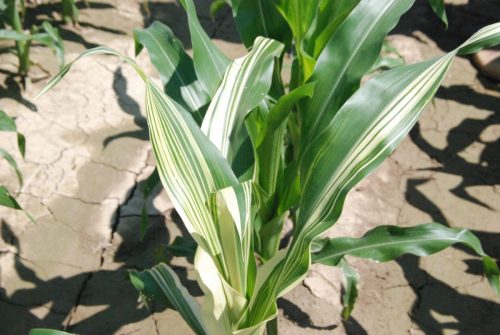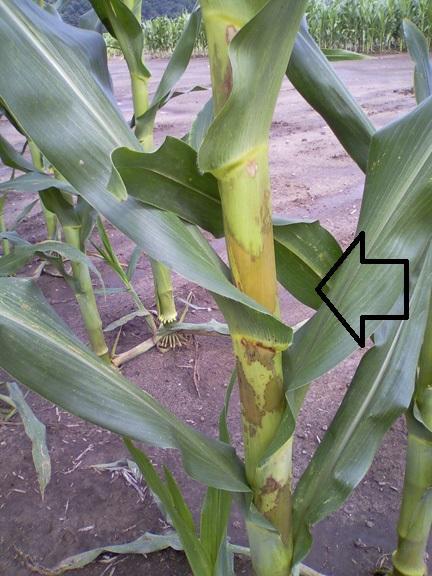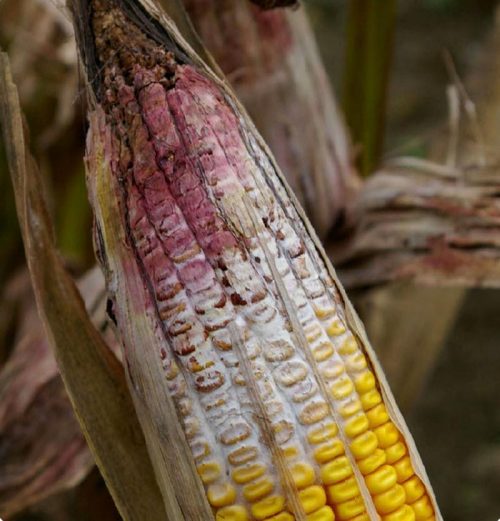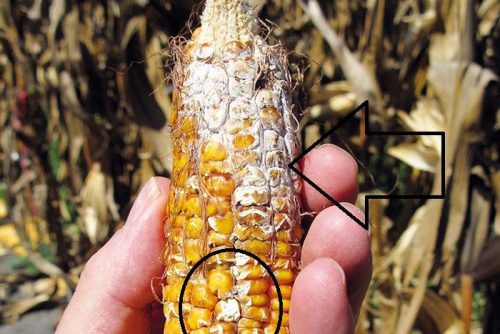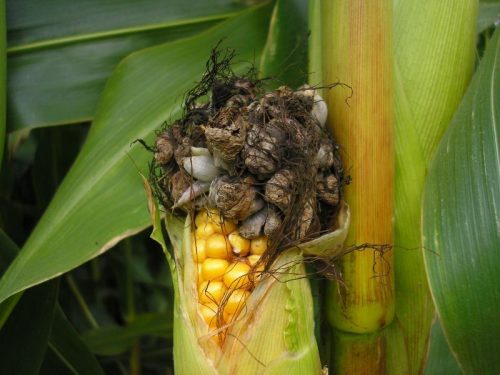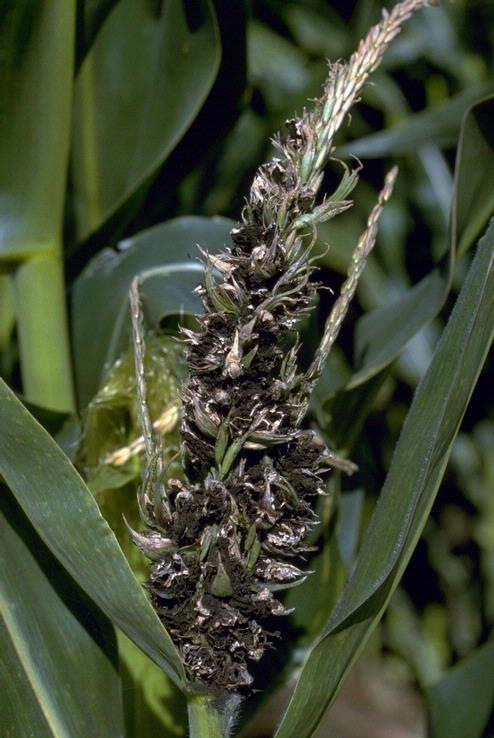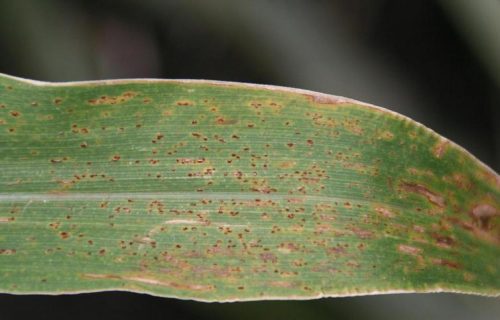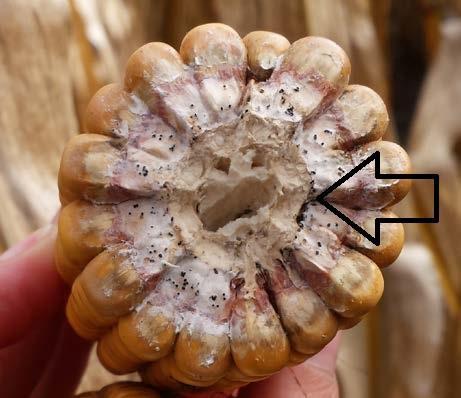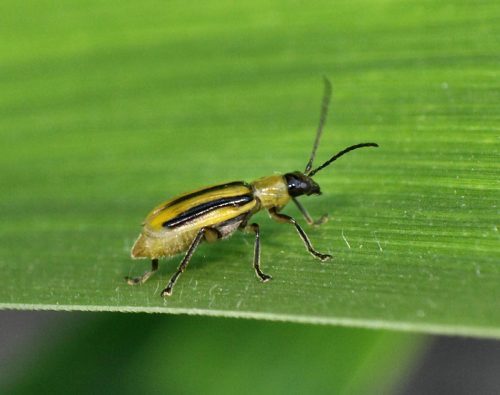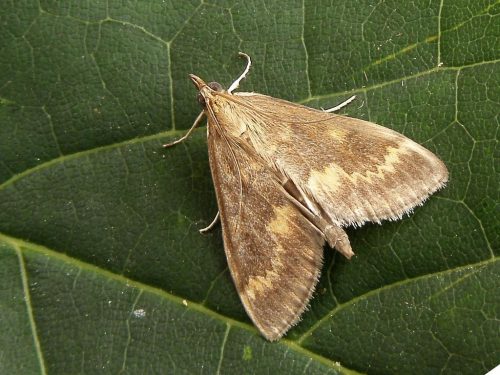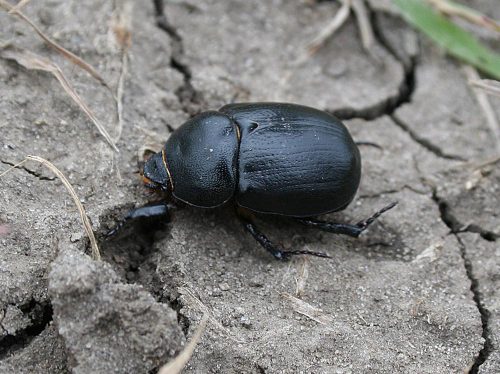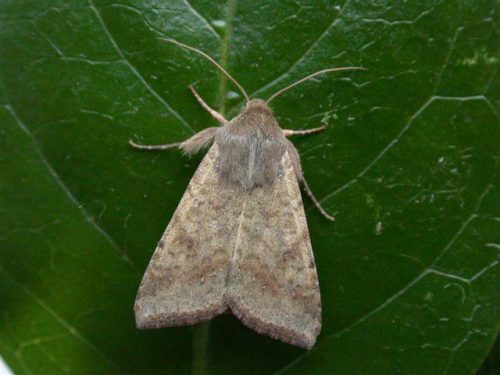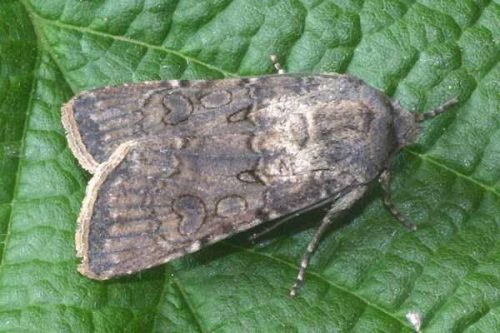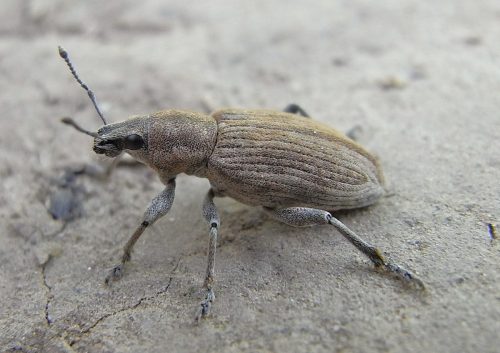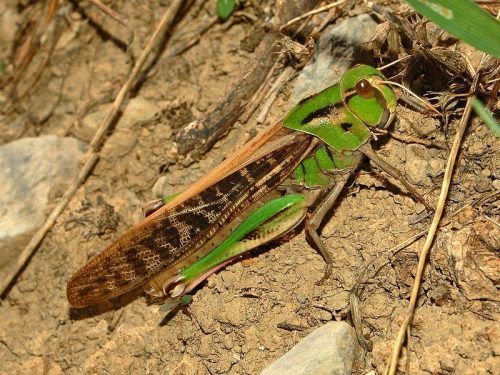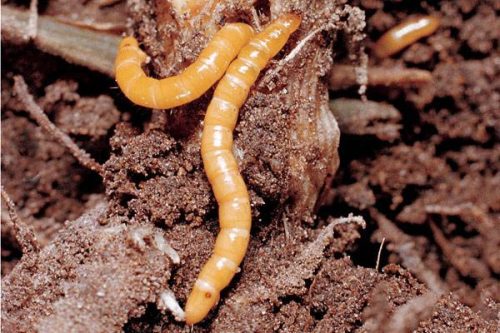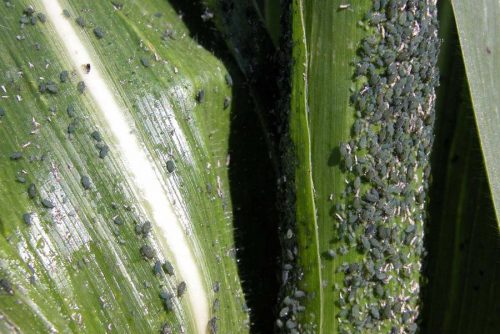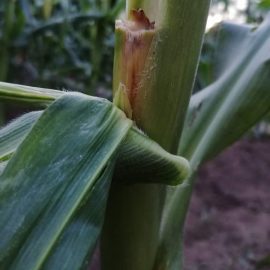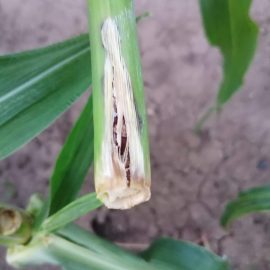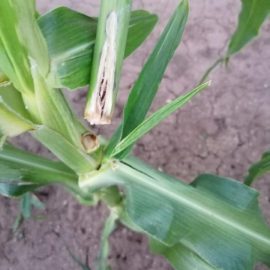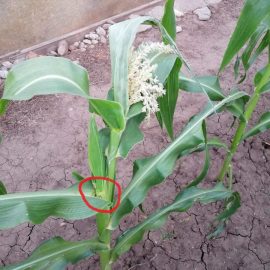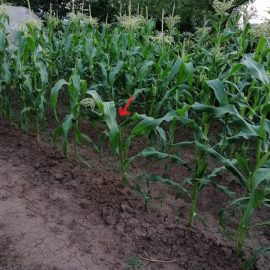Corn treatments, pest and disease control
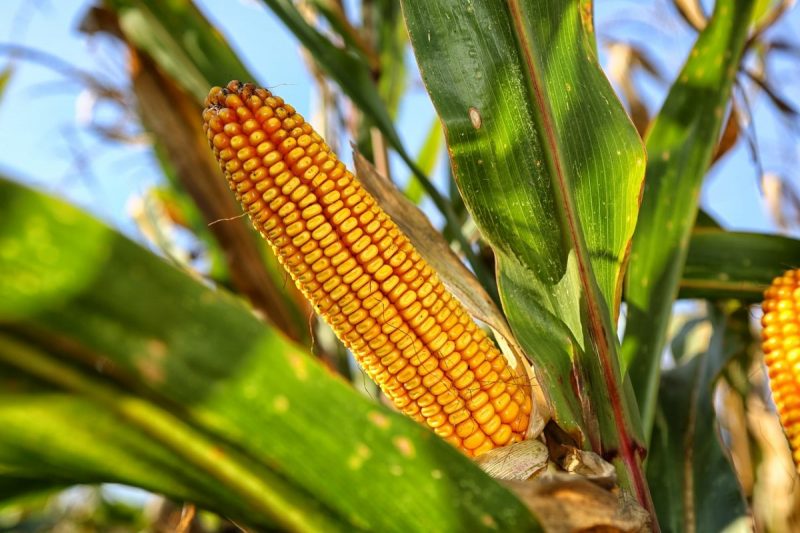
Corn (Zea Mays) is one of the most important cereal species, being cultivated all over the world. The plant is native to Central America from where it has spread to other parts of the world. Wheat and corn crops account for 80% of the world’s grains, being a fairly important food resource. The popularity of this plant is due to its ecological plasticity and chemical composition. Corn adapts well to drought and excessive heat is attacked by a few diseases and pests, and responds well to irrigation and fertilization. Due to its composition, it is used in the food industry, animal feed, and in the alcohol industry.
The main diseases of corn
European maize mosaic virus
This virus occurs mainly in dry and hot years. Representative symptoms occur when the plants are 50-60 cm tall. At the base of the young leaves appear light green spots. As the disease progresses, the spots merge and form yellow stripes, parallel to the ribs. Thus, the plant acquires a mosaic appearance. Also, the attacked plants are small, sterile, or produce small amounts of seeds. The transmission of this virus is done by cane. The virus overwinters in the rhizomes of the cane plant, and in the spring, the aphids transmit the virus to the corn plants.
Prevention and control measures:
- cane control with specific herbicides;
- a correct crop rotation;
- aphids control since they are responsible for transmitting the virus.
Bacterial stalk rot of maize (Erwinia chrysanthemi pv. zeae)
The disease manifests on the stem. Thus, in the areas near the nodes appear spots with the size of 10-20 cm, dark in color. The attacked tissues decompose and the plant loses its mechanical strength. The leaves above the attacked area dry out, and the roots turn reddish and become brittle.
Prevention and control measures:
- a correct crop rotation;
- cultivating resistant hybrids;
- using certified seeds, from a reliable source;
Fusarium head blight (Gibberella zeae)
The disease can be found in temperate and humid areas and it attacks the plants from the seedling phase. The attack on the stem manifests on the basal internodes. They turn yellow, then turn brown. The most common attack is recorded on the cobs. They are covered with a pink mold, and the grains are invaded by the mycelium. The seeds have low germination capacity and are dry. In conditions of high humidity, the cobs rot completely. Corn attacked by Fusarium head blight is toxic and can cause poisoning in humans and animals. Transmission from one year to another is done through infected seeds and mycelium remaining on plant remains or in the soil.
Prevention and control measures:
- a correct crop rotation;
- treating the seeds with specific fungicides.
Bakanae disease (Gibberella fujikuroi)
This fungus attack plants in all phases of vegetative growth, but the characteristic attack manifests on the cobs. Thus, after the attack, the seeds crack, and the grains look like popcorn. The seeds that did not break are covered with pink mycelium. This disease can also occur in storehouses. The disease is transmitted through infected seeds.
Prevention and control measures:
- a correct crop rotation;
- balanced fertilization;
- storing the corn in optimal conditions;
- treating the seeds with specific fungicides.
Corn smut (Ustilago maydis)
The disease attacks all the organs of the plant, commonly infecting the cobs, panicle, and stem. Thus, tumors of different shapes and sizes containing fungal spores appear on the attacked organs. Initially, they are soft, but as the disease progresses, the tumors break and release spores, which reach the soil and will produce infections in the years to come. The attacked organs are deformed and the physiological processes in the plant are slowed down.
Prevention and control measures:
- a correct crop rotation;
- balanced fertilization;
- cultivating resistant hybrids;
- using certified seeds;
- treating the seeds with specific fungicides.
Head smut of maize (Sphacelotheca reiliana)
This fungus attacks the inflorescences of the plant. They are destroyed and turned into a black mass of spores. The disease progresses rapidly, the membrane covering the spores ruptures and releases them. The attacked plants have a small size and reach maturity later than the healthy ones. The disease causes significant damage annually.
Prevention and control measures:
- a correct crop rotation;
- balanced fertilization;
- cultivating resistant hybrids;
- using certified seeds;
- treating the seeds with specific fungicides.
Common rust of maize (Puccinia sorghi)
This fungus appears towards the end of the vegetative growth period. Yellow formations called pustules appear on the plant. The disease progresses and the pustules acquire a blackish-brown color. Then, the leaves turn yellow and dry out. Thus, the capacity for photosynthesis is reduced.
Prevention and control measures:
- carrying out basic plowing;
- sowing at the right time and at the optimum density;
- cultivating resistant hybrids;
- carrying out treatments with specific fungicides.
Recommended products
-
You can find products on a different store
Change Store -
You can find products on a different store
Change Store -
You can find products on a different store
Change Store -
You can find products on a different store
Change Store -
You can find products on a different store
Change Store -
You can find products on a different store
Change Store -
You can find products on a different store
Change Store -
You can find products on a different store
Change Store -
You can find products on a different store
Change Store -
You can find products on a different store
Change Store -
You can find products on a different store
Change Store -
You can find products on a different store
Change Store -
You can find products on a different store
Change Store -
You can find products on a different store
Change Store -
You can find products on a different store
Change Store -
You can find products on a different store
Change Store -
You can find products on a different store
Change Store -
You can find products on a different store
Change Store -
You can find products on a different store
Change Store -
You can find products on a different store
Change Store -
You can find products on a different store
Change Store -
You can find products on a different store
Change Store -
You can find products on a different store
Change Store -
You can find products on a different store
Change Store
Diplodia ear and stalk rot (Nigrospora oryzae)
This fungus attacks plants both in storehouses and in the field. An important symptom is the dry rotting of the stalk. It becomes brittle, while the berries are dry, light, and without any shine. The disease is easily recognized when the seeds do not come off the cob, even if it is very flexible.
Prevention and control measures:
- disinfecting the storage spaces;
- using well-fermented organic fertilizers;
- treating the seeds with specific fungicides.
Northern corn leaf blight (Helminthosporium turcicum)
The disease manifests in areas where humidity and temperatures are high, damaging over 30% of the crop in unfavorable years. Large, oval spots appear on the leaves, bordered by a brown halo. The spots expand, merge and cover large areas of the leaf. In wet weather, a fine mold appears on the surface of the spots, which represents the fructification of the fungi. In dry weather, the leaves dry out and the affected tissues break, causing the leaves to rip.
Prevention and control measures:
- deep autumn plowing;
- optimum density;
- a correct crop rotation;
- cultivating resistant hybrids;
- carrying out treatments with specific fungicides.
Recommended products
-
You can find products on a different store
Change Store -
You can find products on a different store
Change Store -
You can find products on a different store
Change Store -
You can find products on a different store
Change Store -
You can find products on a different store
Change Store -
You can find products on a different store
Change Store -
You can find products on a different store
Change Store -
You can find products on a different store
Change Store -
You can find products on a different store
Change Store -
You can find products on a different store
Change Store -
You can find products on a different store
Change Store -
You can find products on a different store
Change Store -
You can find products on a different store
Change Store -
You can find products on a different store
Change Store -
You can find products on a different store
Change Store -
You can find products on a different store
Change Store -
You can find products on a different store
Change Store -
You can find products on a different store
Change Store -
You can find products on a different store
Change Store -
You can find products on a different store
Change Store -
You can find products on a different store
Change Store -
You can find products on a different store
Change Store -
You can find products on a different store
Change Store -
You can find products on a different store
Change Store
The main pests of corn
The western corn rootworm (Diabrotica virgifera virgifera)
It produces one generation per year and overwinters in the egg stage in the surface layer of the soil, near the corn plants. The larvae appear in May and feed on the corn roots. Following the attack, the root system is destroyed and the phenomenon of falling plants occurs. The adults pierce the leaves and then feed on pollen and silk.
Control measures:
- a correct crop rotation;
- using pheromone traps to avoid the mating of the adults;
- applying treatments if there are more than 10 adults on a plant.
Recommended products
-
You can find products on a different store
Change Store -
You can find products on a different store
Change Store -
You can find products on a different store
Change Store -
You can find products on a different store
Change Store -
You can find products on a different store
Change Store -
You can find products on a different store
Change Store -
You can find products on a different store
Change Store -
You can find products on a different store
Change Store -
You can find products on a different store
Change Store -
You can find products on a different store
Change Store -
You can find products on a different store
Change Store -
You can find products on a different store
Change Store -
You can find products on a different store
Change Store -
You can find products on a different store
Change Store -
You can find products on a different store
Change Store -
You can find products on a different store
Change Store -
You can find products on a different store
Change Store -
You can find products on a different store
Change Store -
You can find products on a different store
Change Store -
You can find products on a different store
Change Store -
You can find products on a different store
Change Store -
You can find products on a different store
Change Store -
You can find products on a different store
Change Store -
You can find products on a different store
Change Store
The European corn borer (Ostrinia nubilalis)
It produces two generations a year and overwinters in the larval stage in the corn cobs. The adults appear at the end of June and lay their eggs on the underside of the leaves. After hatching, the larvae feed on the panicle of the plant, then penetrate inside the stem and consume the marrow. Following the attack, the development of the plant is slowed down and the stems can break.
Control measures:
- burning the vegetable remains, after harvest;
- deep autumn plowing;
- cultivating resistant hybrids;
- when 50% of the plants have perforations, treatments with specific insecticides have to be applied.
Recommended products
-
You can find products on a different store
Change Store -
You can find products on a different store
Change Store -
You can find products on a different store
Change Store -
You can find products on a different store
Change Store -
You can find products on a different store
Change Store -
You can find products on a different store
Change Store -
You can find products on a different store
Change Store -
You can find products on a different store
Change Store -
You can find products on a different store
Change Store -
You can find products on a different store
Change Store -
You can find products on a different store
Change Store -
You can find products on a different store
Change Store -
You can find products on a different store
Change Store -
You can find products on a different store
Change Store -
You can find products on a different store
Change Store -
You can find products on a different store
Change Store -
You can find products on a different store
Change Store -
You can find products on a different store
Change Store -
You can find products on a different store
Change Store -
You can find products on a different store
Change Store -
You can find products on a different store
Change Store -
You can find products on a different store
Change Store -
You can find products on a different store
Change Store -
You can find products on a different store
Change Store
Scarabaeus monodon (Pentodon idiota)
It produces a generation once every three years and overwinters in the larval or adult stage in the surface layer of the soil. Adults attack the plant at various stages of development. They gnaw holes in the area between the roots and the stem and interrupt the circulation of the intracellular fluids of the plant. Following the attack, the plants wither. The larvae are not dangerous.
Control measures:
- deep autumn plowing;
- cultivating resistant hybrids;
- carrying out treatments with specific insecticides.
The cotton bollworm (Helicoverpa armigera armigera)
It produces 2-3 generations per year and overwinters in the larval stage in the soil. It is a polyphagous species that attacks over 120 species of cultivated plants. The larvae initially eat the silk and then the grains from the top of the cobs.
Control measures:
- avoiding monoculture;
- deep summer plowing;
- carrying out treatments with specific insecticides.
Recommended products
-
You can find products on a different store
Change Store -
You can find products on a different store
Change Store -
You can find products on a different store
Change Store -
You can find products on a different store
Change Store -
You can find products on a different store
Change Store -
You can find products on a different store
Change Store -
You can find products on a different store
Change Store -
You can find products on a different store
Change Store -
You can find products on a different store
Change Store -
You can find products on a different store
Change Store -
You can find products on a different store
Change Store -
You can find products on a different store
Change Store -
You can find products on a different store
Change Store -
You can find products on a different store
Change Store -
You can find products on a different store
Change Store -
You can find products on a different store
Change Store -
You can find products on a different store
Change Store -
You can find products on a different store
Change Store -
You can find products on a different store
Change Store -
You can find products on a different store
Change Store -
You can find products on a different store
Change Store -
You can find products on a different store
Change Store -
You can find products on a different store
Change Store -
You can find products on a different store
Change Store
Turnip moth (Agrotis segetum)
It produces two generations a year and overwinters in the larval stage in the soil. It is a polyphagous species that can attack several plant species (sugar beet, sunflower, wheat, barley). The larvae initially feed on the aerial parts, then enter the soil and gnaw galleries the area between the roots and the stem. As a result of the attack, the plants die.
Control measures:
- deep autumn plowing;
- treating the seeds before sowing;
- carrying out treatments during the vegetative growth period with specific insecticides.
Recommended products
-
You can find products on a different store
Change Store -
You can find products on a different store
Change Store -
You can find products on a different store
Change Store -
You can find products on a different store
Change Store -
You can find products on a different store
Change Store -
You can find products on a different store
Change Store -
You can find products on a different store
Change Store -
You can find products on a different store
Change Store -
You can find products on a different store
Change Store -
You can find products on a different store
Change Store -
You can find products on a different store
Change Store -
You can find products on a different store
Change Store -
You can find products on a different store
Change Store -
You can find products on a different store
Change Store -
You can find products on a different store
Change Store -
You can find products on a different store
Change Store -
You can find products on a different store
Change Store -
You can find products on a different store
Change Store -
You can find products on a different store
Change Store -
You can find products on a different store
Change Store -
You can find products on a different store
Change Store -
You can find products on a different store
Change Store -
You can find products on a different store
Change Store -
You can find products on a different store
Change Store
The grey corn weevil (Tanymecus dilaticollis)
It produces one generation per year and overwinters in the adult stage in the soil. The adults appear at the end of March when the temperatures exceed 9° C. It is a polyphagous species, but it causes the biggest damage to corn crops. Adults gnaw the leaves from the sprouting phase. After the plant has developed 4 true leaves, this pest is no longer a danger.
Control measures:
- treating the seeds before sowing;
- deep winter plowing;
- early sowing;
- carrying out treatments during the vegetative growth period with specific insecticides.
Recommended products
-
You can find products on a different store
Change Store -
You can find products on a different store
Change Store -
You can find products on a different store
Change Store -
You can find products on a different store
Change Store -
You can find products on a different store
Change Store -
You can find products on a different store
Change Store -
You can find products on a different store
Change Store -
You can find products on a different store
Change Store -
You can find products on a different store
Change Store -
You can find products on a different store
Change Store -
You can find products on a different store
Change Store -
You can find products on a different store
Change Store -
You can find products on a different store
Change Store -
You can find products on a different store
Change Store -
You can find products on a different store
Change Store -
You can find products on a different store
Change Store -
You can find products on a different store
Change Store -
You can find products on a different store
Change Store -
You can find products on a different store
Change Store -
You can find products on a different store
Change Store -
You can find products on a different store
Change Store -
You can find products on a different store
Change Store -
You can find products on a different store
Change Store -
You can find products on a different store
Change Store
Migratory locust (Locusta migratoria)
It is a polyphagous species that have high ecological plasticity. It produces only one generation per year and overwinters in the egg stage in the surface layer of the soil. This pest aggressively attacks most crops. It attacks the aerial parts, leaving the thick and strong stems intact. It is a very dangerous species and it is difficult to control because it attacks in the form of colonies. Thus, in a few hours, it can destroy tens of hectares of crops.
Control measures:
- monitoring the locust population if crops are near risk areas;
- applying treatments with specific insecticides, if there is a warning.
Wireworms (Agriotes sp.)
These insects are the larvae of click beetles. They overwinter in the soil as larvae of different stages and produce a generation once every 4-5 years. Wireworms are very dangerous because their attack cannot be identified quickly. They consume the root system, and the plant withers and dies.
Control measures:
- deep autumn plowing;
- treating the seeds before sowing;
- a crop rotation that includes less attacked species (peas, beans, soybeans, rapeseed, mustard);
- carrying out treatments with specific insecticides.
Recommended products
-
You can find products on a different store
Change Store -
You can find products on a different store
Change Store -
You can find products on a different store
Change Store -
You can find products on a different store
Change Store -
You can find products on a different store
Change Store -
You can find products on a different store
Change Store -
You can find products on a different store
Change Store -
You can find products on a different store
Change Store -
You can find products on a different store
Change Store -
You can find products on a different store
Change Store -
You can find products on a different store
Change Store -
You can find products on a different store
Change Store -
You can find products on a different store
Change Store -
You can find products on a different store
Change Store -
You can find products on a different store
Change Store -
You can find products on a different store
Change Store -
You can find products on a different store
Change Store -
You can find products on a different store
Change Store -
You can find products on a different store
Change Store -
You can find products on a different store
Change Store -
You can find products on a different store
Change Store -
You can find products on a different store
Change Store -
You can find products on a different store
Change Store -
You can find products on a different store
Change Store
Wheat aphid (Schizaphis graminum)
It produces 15-20 generations per year and overwinters in the egg stage on barley or on spontaneous species. The adults and larvae colonize the leaves and stems, where they suck the intracellular fluid from the tissue. The attacked leaves have red spots, curl up, and then dry. Strong attacks occurring in autumn determine the drying of the plants, and during the development of the grains, it determines the decrease in production.
Prevention and control measures:
- sowing at the optimum time is recommended;
- weed destruction;
- applying treatments when there are more than 10 insects on a plant.
Recommended products
-
You can find products on a different store
Change Store -
You can find products on a different store
Change Store -
You can find products on a different store
Change Store -
You can find products on a different store
Change Store -
You can find products on a different store
Change Store -
You can find products on a different store
Change Store -
You can find products on a different store
Change Store -
You can find products on a different store
Change Store -
You can find products on a different store
Change Store -
You can find products on a different store
Change Store -
You can find products on a different store
Change Store -
You can find products on a different store
Change Store -
You can find products on a different store
Change Store -
You can find products on a different store
Change Store -
You can find products on a different store
Change Store -
You can find products on a different store
Change Store -
You can find products on a different store
Change Store -
You can find products on a different store
Change Store -
You can find products on a different store
Change Store -
You can find products on a different store
Change Store -
You can find products on a different store
Change Store -
You can find products on a different store
Change Store -
You can find products on a different store
Change Store -
You can find products on a different store
Change Store














































































































































































































































































































































































































































